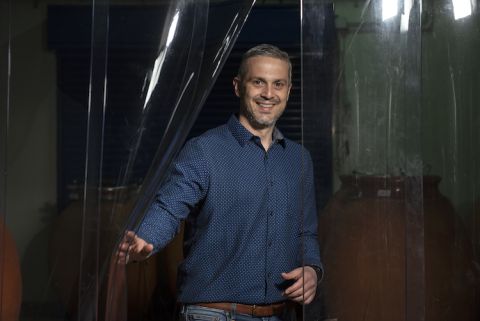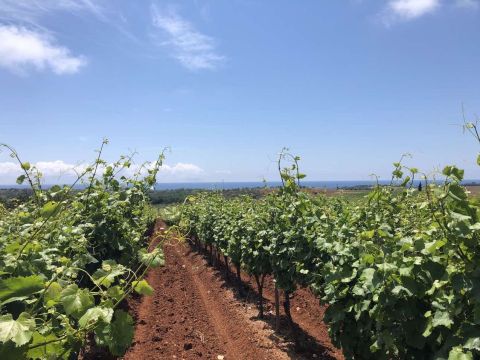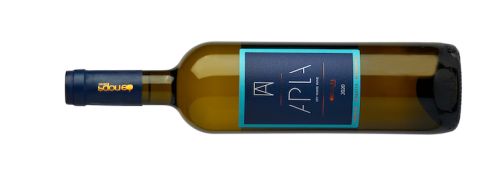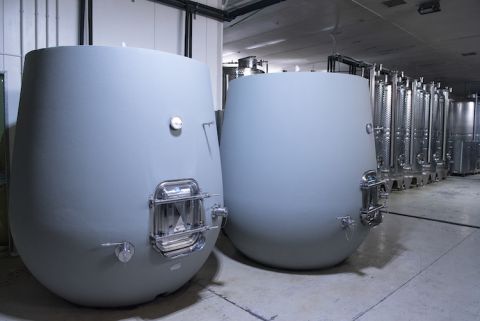Oenops, Apla 2020 (white) and 2019 (red) Greece
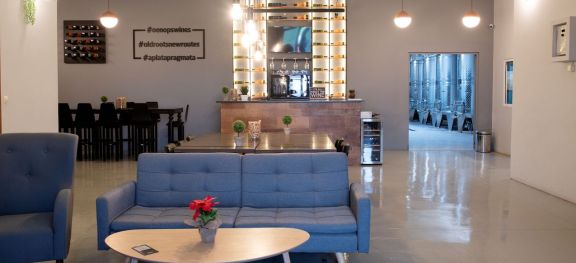
Brilliantly good-value emissaries from Greece.
From €11.40, 65 Romanian lei, $15.19, £12.88, 19 Swiss francs, 194.90 Norwegian kroner
I was seriously impressed by this current pair of Greek wines from Nikos Karatzas when I tasted them recently.
Here's what Clark Foyster, UK importer of Oenops wines, has to say about this very accomplished new(ish) talent:
'Nikos Karatzas is the face behind Oenops (= "wine face"). He is intense, ambitious and confident in what he is doing. He studied in Bordeaux and then became chief winemaker at a very young age at the high-profile Pavlidis winery [see Julia’s 2008 profile], also in Drama, before setting up his own project in 2015. He is a member of the new generation, proud of Greece's terroirs and indigenous varieties.
'He had his fill of international varieties in his previous job. Now his mission is to source great fruit and craft great wines from it. This is the focus of Oenops, and it "costs" him 50,000 km per year, touring the country and looking for interesting projects. So he is probably best described as a micro-négociant, working in partnership with growers who share his ideas.
'He works from an old pie factory [clearly smartened up, to judge from the image above – JR] just outside Drama in eastern Macedonia, which he has filled with concrete tanks, some stainless steel, some oak and some amphoras which he loves. Now his own boss, he is clearly adoring the freedom to experiment, and his confidence for what he is sure he can achieve in the future is very infectious.'
Karatzas himself, pictured above, explains:
'In Oenops Wines, we own no vineyards; we are working with indigenous varieties from selected terroirs/regions in Greece, primarily cool-climate sites and aged vines. Above all, we are working with ambitious growers with a sustainable philosophy approach. As we want to work in every detail both in vineyards and winery, in order to become "invisible" in terms of intervention in the nature-character of the wine, we vinify every plot separately; each plot is at least one lot. This may require much more work, but it helps us understand each vineyard and translate it into a better wine each time; it helps us evolve.
'Our approach in Oenops Wines is to express the typicality a grape may carry from the variety and the place it comes from. We aim to produce authentic, fruit-forward wines. We use no protocols; we taste, taste, and adapt our approach to each lot based on our philosophy. We challenge ourselves to work better every year in the vineyard and the winery. Our goal is to produce tasteful, elegant wines that add some value to the precious moments of the customers.'
The prices are miraculously low for the quality delivered. I marked both the red and the white VGV for 'very good value' when I tasted them during UK retailer Lay & Wheeler’s recent tasting, and, at £12.88 each, they are considerably less expensive than this 2019 wine of the week, an Oenops Vidiano from Crete, chosen by Tim Jackson MW. The Apla packaging, like that of the Cretan Vidiano, is seriously smart.
These two blends, called Apla, or 'Simply', are skilful blends of several different ingredients from different regions – hence the simple 'Greece' appellation. These are my tasting notes on the white:
Oenops, Apla White 2020 Greece 12.5%
60% Malagousia, 30% Assyrtiko, 10% 45-year-old Roditis blend from three different parts of Greece. Aged for just three months in tank or amphora on fine lees before bottling.
Florally fragrant and really very nicely balanced. No one component dominates yet the blend goes on and on in the mouth. This would be a great demonstration of the sophistication of modern Greek wine. Clean and fresh. VGV 16.5 Drink 2022–24
And here's what Karatzas has to say about Apla white: 'It's a blend of 30 different vinifications, although it is a wine that is designed to be consumed mainly within the first year of its release. This is why I am extra happy that you find the 2020 [still] so enjoyable. The 2021 is currently in the market (with a slight change in the blend as we have replaced Roditis with Vidiano, which also adds layers to the wine and another intensity on the nose). The other two varieties are [still] Malagousia and Assyrtiko.'
Oenops, Apla Red 2020 Greece 13%
50% Xinomavro, 30% Limniona, 20% Mavroudi blend from vines of 15 to 50 years old from three different regions.
Lots of interest here with the typical, charred notes of Xinomavro definitely seeming to dominate. This seems to have quite a future too. VGV 16.5 Drink 2022–26
Karatzas on Apla Red: 'It's a blend of different vinifications of Xinomavro, Limniona and Mavroudi. Xinomavro is sourced from four PDO regions of Xinomavro (Amyntaion, Rapsani, Naoussa and Goumenissa), Limniona from mountainous sites of Thessaly, and Mavroudi from Thrace. We have vinifications in stainless steel, concrete and some old, open-top barrels, and the ageing takes place in the same type of vessel for six months.'
The wines are quite widely available in the US and UK, and can also be found in Greece (not surprisingly), Cyprus, Germany, Romania, Bulgaria, Belgium, Switzerland and Norway.
Read over 100 articles that we have written about the Greek wine revolution.
Become a member to view this article and thousands more!
- 15,407 featured articles
- 274,946 wine reviews
- Maps from The World Atlas of Wine, 8th edition (RRP £50)
- The Oxford Companion to Wine, 5th edition (RRP £50)
- Members’ forum
- 15,407 featured articles
- 274,946 wine reviews
- Maps from The World Atlas of Wine, 8th edition (RRP £50)
- The Oxford Companion to Wine, 5th edition (RRP £50)
- Members’ forum
- 48-hour preview of all scheduled articles
- Commercial use of our wine reviews

